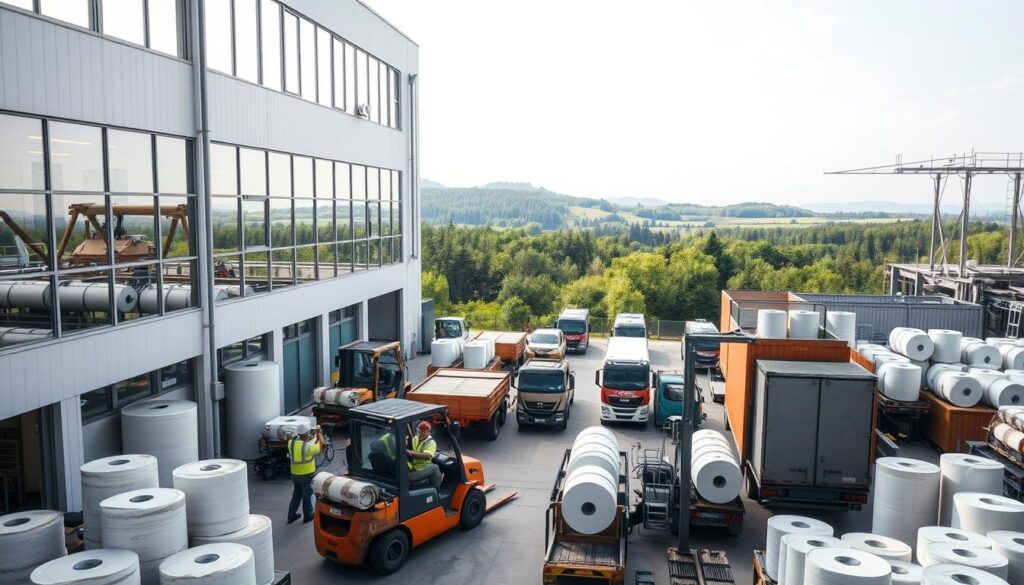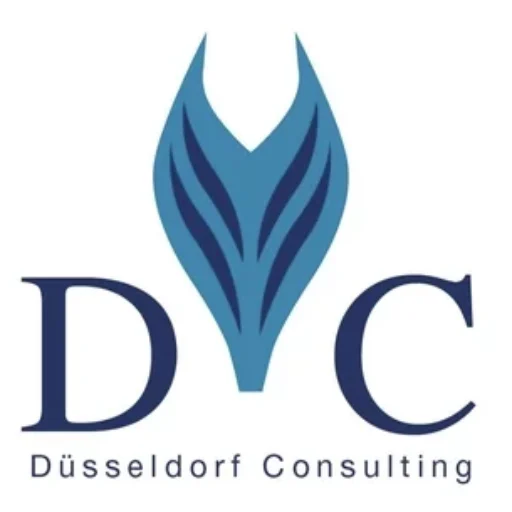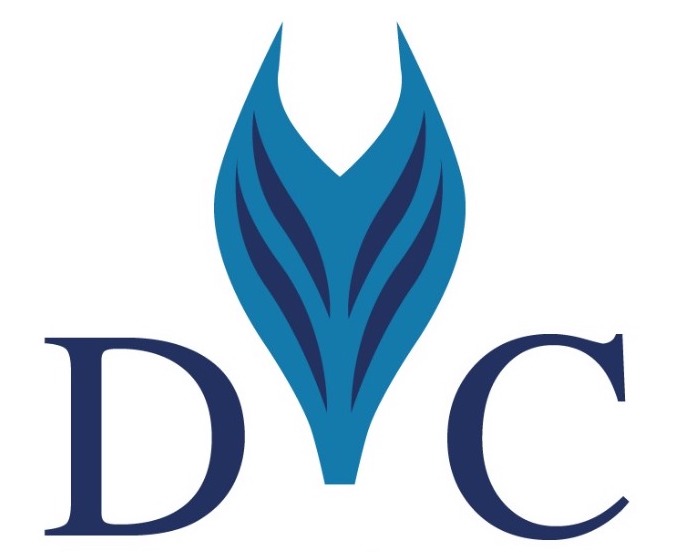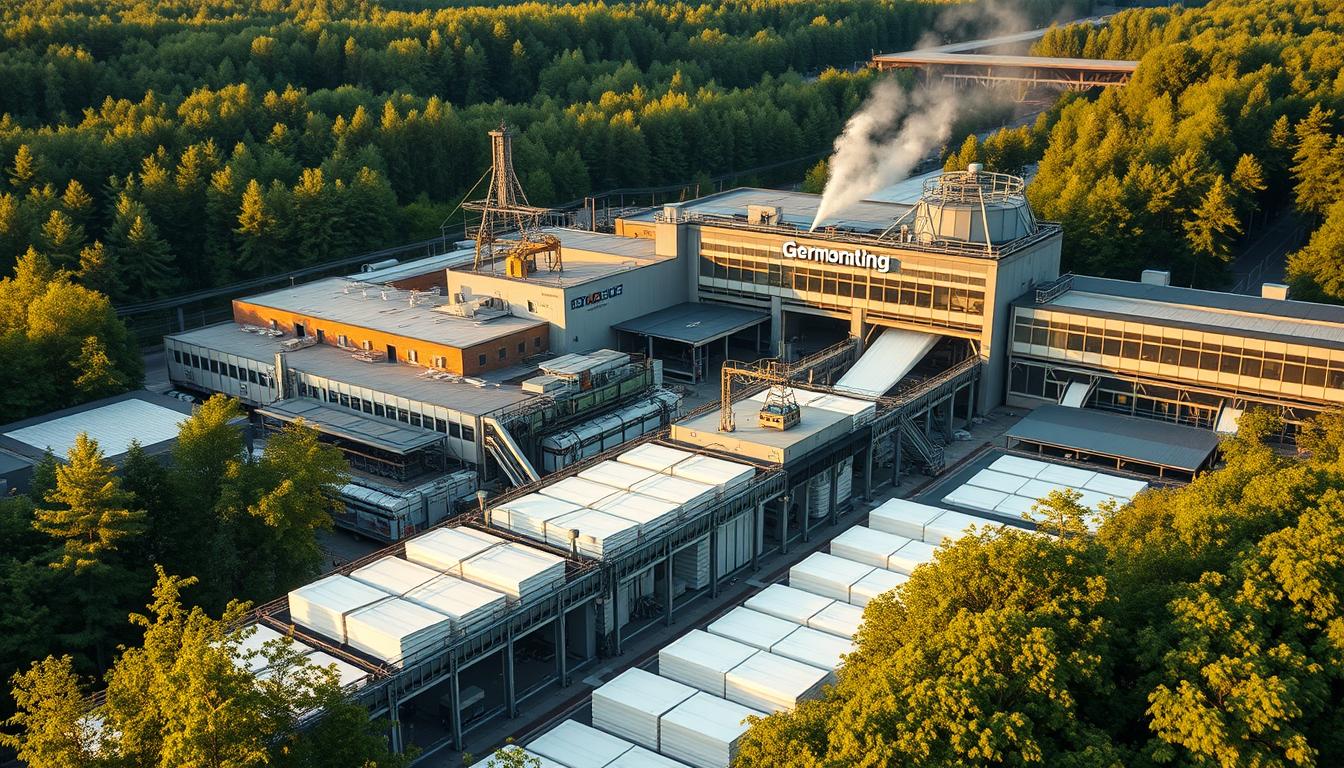Germany stands as the fourth-largest producer of paper globally, boasting a significant presence in the international market. The German paper industry has a rich history and has evolved substantially over the years, adapting to technological advancements and shifting consumer demands.
The paper manufacturing industry in Germany is a vital component of its industrial economy, contributing significantly to its economic output. With a strong focus on innovation and sustainability, the industry continues to thrive, meeting both domestic and international needs.
Key Takeaways
- Germany is the fourth-largest paper producer globally.
- The German paper industry has a rich history and is a significant part of the country’s industrial economy.
- The industry is known for its innovation and sustainability.
- It has adapted to technological advancements and changing consumer demands.
- The industry contributes significantly to Germany’s economic output.
The Historical Evolution of Paper Manufacturing in Germany
The Homburg Paper Mill, established in 1729, is a testament to Germany’s long-standing paper manufacturing tradition. This mill, along with others like the Niederzwönitz Paper Mill, played a crucial role in the early development of the industry.
Over the centuries, Germany’s paper manufacturing sector has undergone significant transformations, driven by technological innovations and changing consumer demands. The introduction of new machinery and production techniques in the 19th century, for example, greatly increased production capacities.

Today, Germany’s paper industry is known for its high-quality products and sustainable practices, building on a legacy that spans over 280 years.
| Year | Milestone |
|---|---|
| 1729 | Establishment of Homburg Paper Mill |
| 19th Century | Introduction of new machinery and production techniques |
Understanding the Paper Manufacturing Industry in Germany Today
Germany is home to a robust paper manufacturing industry, with notable concentrations in the north and south. The industry’s strength is largely attributed to its strategic locations, which offer favorable conditions for production and distribution.
Northern German Paper Valley
The northern region of Germany, often referred to as the “Paper Valley,” is a significant hub for paper manufacturing. This area is characterized by a high concentration of paper mills, benefiting from historical investments and infrastructure. The region’s expertise in paper production is well-established, making it a crucial area for the industry’s growth. For insights into the market trends and execution strategies in Germany’s paper manufacturing sector, you can refer to industry reports.

In addition to the northern regions, southern Germany also hosts significant paper manufacturing facilities. These southern hubs are known for their innovative production techniques and high-quality output. The combination of traditional manufacturing expertise and modern technology enables these regions to maintain a competitive edge in the global market.
The paper manufacturing sector in Germany, including both the northern and southern regions, contributes substantially to the country’s economy. With a focus on sustainability and innovation, the industry is poised for continued success.
Raw Materials and Resources: The Foundation of German Paper Production
The foundation of Germany’s thriving paper industry lies in its access to essential raw materials. The country’s paper production companies rely heavily on renewable resources, including wood pulp and recycled fibers, to manufacture a wide range of paper products.
Renewable Resources: Wood pulp is a primary raw material used in paper production. Germany’s paper industry sources wood pulp from sustainably managed forests, ensuring a consistent supply of this vital resource. Additionally, the industry utilizes recycled fibers, which are sourced from post-consumer waste and production waste.
- Wood pulp from sustainably managed forests
- Recycled fibers from post-consumer waste
- Recycled fibers from production waste
The use of these raw materials not only supports the sustainability of the paper industry but also contributes to the reduction of environmental impacts. Germany’s paper production companies are committed to maintaining a high level of environmental stewardship.
The availability and sourcing of raw materials are crucial for the continued success of Germany’s paper manufacturing industry. By leveraging renewable resources and recycling, the industry is well-positioned to meet the demands of a changing market.
Step-by-Step Guide to the German Paper Manufacturing Process
The production of paper in Germany involves a detailed process that ensures the creation of premium products. This process encompasses several stages, from the initial pulping of raw materials to the final finishing stages.
The journey begins with pulping, where raw materials such as wood chips or recycled paper are broken down into a fibrous mixture. This mixture is then screened and cleaned to remove impurities.
Calendering and Coating
After the paper is formed, it undergoes calendering, a process that involves passing the paper through a series of rollers to smooth and flatten it. Some paper products may also undergo coating, where a layer of coating is applied to enhance printability and appearance.
- Calendering improves the paper’s surface finish.
- Coating enhances the paper’s printability.
Cutting and Packaging
The final stages involve cutting the paper to the desired size and packaging it for distribution. German paper manufacturers utilize advanced machinery to ensure precision and efficiency in these stages.
- Cutting is done using high-precision machinery.
- Packaging is tailored to meet customer requirements.
The German paper manufacturing process is a testament to the country’s commitment to quality and innovation. By understanding each stage of this process, one can appreciate the complexity and expertise involved in producing high-quality paper products.
Leading Paper Manufacturing Companies in Germany: Business Models and Success Factors
Companies like Stora Enso and UPM are at the forefront of Germany’s paper manufacturing industry, driving growth and innovation. These leading paper manufacturers in Germany have established themselves through their commitment to quality, sustainability, and technological advancement.
Stora Enso, for instance, has a long history of innovation in the paper industry. Their business model focuses on producing high-quality paper products while minimizing environmental impact. This approach has not only contributed to their success but also raised the standards within the German paper industry.
UPM is another significant player, known for its diverse product portfolio and commitment to sustainability. By investing in renewable energy and implementing efficient production processes, UPM has become a benchmark for sustainability in the industry.
The success of these companies can be attributed to their ability to adapt to changing market demands and their focus on innovation. As the German paper industry continues to evolve, these leading manufacturers are likely to remain at the forefront, driving future developments.
Technological Innovations Transforming the German Paper Industry
Innovative technologies are playing a crucial role in shaping the future of paper production in Germany. The industry is witnessing a significant shift towards automation and digitalization, enhancing efficiency and product quality.
Real-time Quality Control Systems
The adoption of real-time quality control systems is one of the key technological advancements in the German paper manufacturing industry. These systems enable manufacturers to monitor production processes continuously, detecting any deviations or defects instantly. This allows for immediate corrective actions, reducing waste and improving overall product quality.
The benefits of real-time quality control include:
- Enhanced product consistency
- Reduced production downtime
- Improved customer satisfaction
Predictive Maintenance Solutions
Another significant technological innovation is the implementation of predictive maintenance solutions. By leveraging data analytics and machine learning algorithms, manufacturers can predict when equipment is likely to fail or require maintenance. This proactive approach minimizes unplanned downtime, extends equipment lifespan, and optimizes maintenance schedules.
The advantages of predictive maintenance include:
- Reduced maintenance costs
- Increased production uptime
- Improved supply chain reliability
The integration of these technological innovations is transforming the German paper manufacturing industry, making it more competitive and sustainable. As the industry continues to evolve, we can expect to see further advancements in automation, digitalization, and data-driven decision-making.
How to Implement Sustainability Practices from Germany’s Paper Manufacturing Industry
Sustainability is at the forefront of Germany’s paper manufacturing sector, driving innovation and efficiency. The industry has made significant strides in reducing its environmental footprint, with a high recycling rate being a notable achievement. As the world looks towards more sustainable practices, Germany’s paper manufacturing industry serves as a valuable example.
One of the key sustainability practices in Germany’s paper manufacturing is the use of recycled fibers. The industry has developed advanced technologies to process and utilize recycled fibers, significantly reducing the need for virgin wood pulp. This not only conserves natural resources but also decreases the energy required for production. According to industry statistics, a substantial portion of Germany’s paper production is based on recycled materials, showcasing the industry’s commitment to sustainability.
Another crucial aspect is the reduction of water and energy consumption. German paper manufacturers have implemented various technologies to minimize their environmental impact, such as closed-loop water systems and energy-efficient production processes. These efforts have led to a significant reduction in the industry’s overall environmental footprint.
Achieving Sustainability through Innovation
Innovation plays a vital role in the sustainability of Germany’s paper manufacturing industry. Companies are continually investing in research and development to improve production processes and reduce environmental impact. For instance, the development of new bleaching technologies that reduce chemical usage and the implementation of biogas plants that utilize production waste are examples of innovative sustainability practices.
“The paper industry’s commitment to sustainability is not just about reducing environmental impact; it’s also about ensuring the long-term viability of our business.” –
To implement such sustainability practices, companies can follow a few key steps:
- Conduct a thorough assessment of current production processes to identify areas for improvement.
- Invest in technologies that reduce energy and water consumption.
- Implement recycling programs for both internal process waste and consumer waste.
- Continuously monitor and report on sustainability metrics to ensure progress towards goals.
By adopting these practices, paper manufacturers can not only reduce their environmental impact but also improve their operational efficiency and contribute to a more sustainable future.
Specialty Paper Production: Learning from Germany’s Niche Expertise
Specialty paper production is a hallmark of Germany’s paper industry, known for its high-quality and innovative products. The German paper industry has a long tradition of producing specialty papers that cater to diverse applications across various sectors.
These specialty papers include, but are not limited to, filter papers, cigarette papers, and packaging papers with special properties. The production of such papers requires advanced technology and a deep understanding of the specific needs of different industries.
| Type of Specialty Paper | Application | Key Feature |
|---|---|---|
| Filter Papers | Industrial Filtration | High filtration efficiency |
| Cigarette Papers | Tobacco Industry | Controlled burn rate |
| Special Packaging Papers | Food and Luxury Goods | Water and grease resistance |
The expertise involved in manufacturing these specialty papers is a testament to the German paper industry’s commitment to innovation and quality. By understanding the specific requirements of each application, German manufacturers are able to produce papers that meet the highest standards.
Navigating Challenges in the Paper Manufacturing Industry in Germany
Germany’s paper production companies are navigating a complex environment marked by digital transformation and shifting consumer demands. The industry faces significant challenges, including the impact of digitalization on traditional paper products and evolving consumer preferences towards sustainable and eco-friendly products.
The paper manufacturing sector in Germany must adapt to these changes by embracing digital transformation and innovating their production processes. This involves not only adopting new technologies but also rethinking business models to remain competitive in a rapidly changing market.
Digital Transformation Responses
One of the key responses to the challenges faced by the industry is the adoption of digital transformation strategies. This includes the integration of digital technologies into production processes, enhancing efficiency, and reducing costs. Companies like Mondi and Sappi are leading the way in this area, investing heavily in digitalization and automation.
Another critical approach is the development of new products that meet the changing needs of consumers. This includes the production of specialty papers, such as packaging materials that are both sustainable and functional. Companies are also focusing on developing products with unique properties, such as enhanced durability or recyclability.
| Company | Product Innovation | Digital Transformation |
|---|---|---|
| Mondi | Sustainable packaging solutions | Advanced automation technologies |
| Sappi | Specialty papers for industrial applications | Digital printing technologies |
| Stora Enso | Biodegradable packaging materials | Smart manufacturing processes |
By adopting these strategies, German paper manufacturers can not only navigate the current challenges but also position themselves for future success in a rapidly evolving industry.
Accessing Government Support for German Paper Manufacturers
To stay competitive, German paper manufacturers can leverage government support aimed at promoting sustainability and innovation. The German government recognizes the importance of its paper manufacturing industry and offers various forms of support to ensure its continued growth and environmental sustainability.
The government provides incentives for adopting sustainable practices and investing in new technologies. For instance, subsidies are available for companies that implement energy-efficient production processes or utilize recycled fibers in their products. These incentives not only help reduce the environmental footprint of paper manufacturing but also enhance the industry’s competitiveness in the global market.
Additionally, government-backed research and development programs support the innovation of new paper products and manufacturing techniques. This support enables German paper manufacturers to stay at the forefront of technological advancements and respond effectively to changing market demands.
By accessing these government support programs, paper manufacturers in Germany can improve their operational efficiency, reduce costs, and contribute to a more sustainable future. It is essential for industry stakeholders to stay informed about the available support measures and to actively engage with government initiatives.
Future Trends and Opportunities: Strategic Planning for German Paper Manufacturing
Future trends in paper manufacturing, such as digitalization and sustainable practices, will play a pivotal role in shaping Germany’s paper industry. As companies navigate these changes, strategic planning will be crucial for success.
Sustainability remains a key driver, with manufacturers focusing on eco-friendly products and production processes. “The shift towards sustainability is not just a trend, but a necessity for the survival of the paper industry,” as noted by industry experts.
The industry is also witnessing significant advancements in digitalization, with the integration of digital technologies into production processes. This not only enhances efficiency but also opens up new opportunities for innovation.
To remain competitive, German paper manufacturers must invest in research and development, focusing on emerging trends and technologies. By doing so, they can capitalize on new opportunities and drive growth in a rapidly evolving market.
According to industry statistics, the German paper manufacturing industry is poised for steady growth, driven by increasing demand for sustainable and high-quality paper products.
Conclusion: The Enduring Strength and Lessons from Germany’s Paper Industry
Germany’s paper manufacturing industry has demonstrated remarkable resilience and adaptability, enabling it to thrive in a competitive global market. The industry’s commitment to sustainability, technological innovation, and quality production has positioned it for continued success.
The german paper industry has a rich history, and its evolution has been shaped by factors such as raw material sourcing, manufacturing processes, and market trends. Today, the paper manufacturing industry in germany is a significant player in the global paper market, with a strong focus on specialty paper production and sustainable practices.
As the industry looks to the future, it is likely to be shaped by trends such as digitalization, environmental sustainability, and changing consumer demands. By understanding the key drivers of the german paper industry, businesses and policymakers can identify opportunities for growth and development, while also addressing the challenges that lie ahead.



